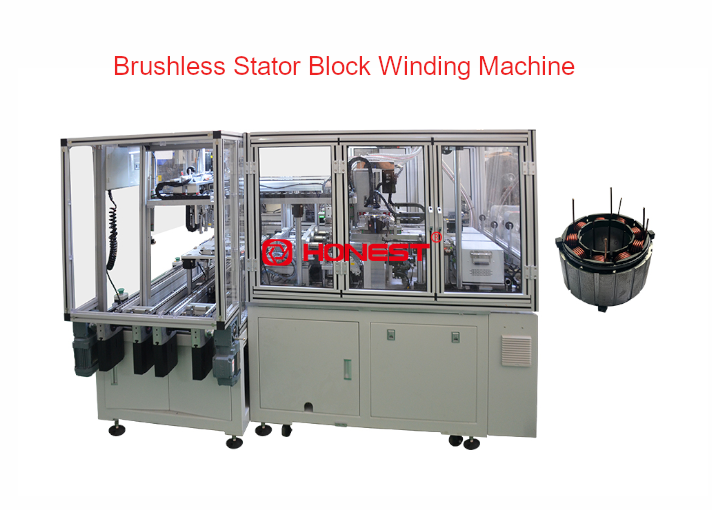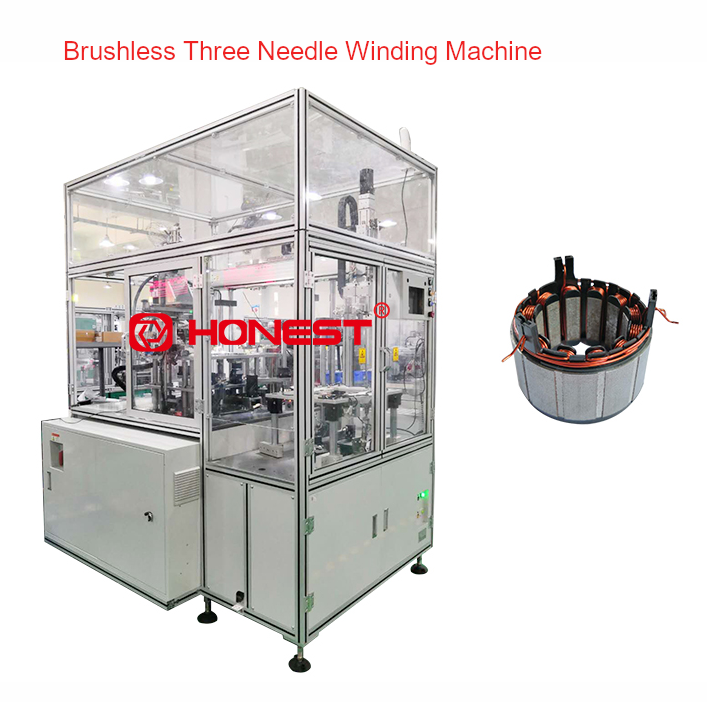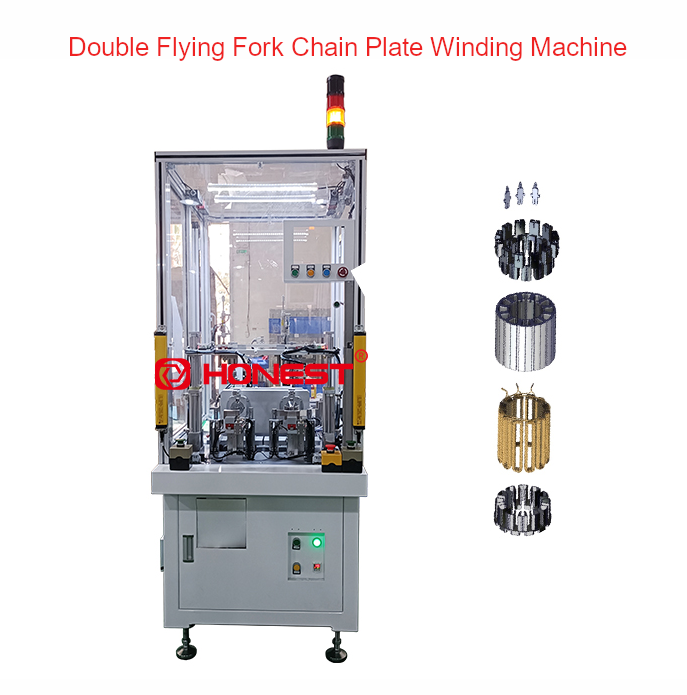As a supplier of motor winding machines with a history of 18 years, HONEST Automation is committed to becoming a leader in the field of intelligent motor equipment in China. Over the 18 years, we have consistently pursued learning and innovation, hoping to enhance our customer’s production efficiency by providing high-quality and efficient motor winding machines, addressing the two major issues of efficiency and cost.
Motor winding machines hold a core position in motor manufacturing equipment. They are responsible for winding the conductors in a specific manner around the stator or rotor of the motor to form the motor’s coils. The quality of the coils and the winding process largely determine the performance of the motor. Based on the winding method, winding machines can be divided into flat winding machines, needle winding machines, and flying fork winding machines. Here is a detailed explanation of these three types of winding machines.
A.Flat Winding Machine
The flat winding machine is a common winding equipment, mainly used for winding the wire in a spiral form around the workpiece. It achieves this by rotating the main shaft and moving in three-dimensional space to position the wire in a spiral arrangement on the outer layer of the workpiece. This winding method results in uniform and compact coils, suitable for most transformers, inductors, and various types of coil winding.
The advantages of flat winding machines:
1. Natural winding, with fewer contact surfaces with the wire, reducing wire damage;
2. Simple wire path, low resistance, direct tension recovery, easy to control the wire arrangement;
3. The wire does not twist by itself, and multi-wire parallel winding does not affect the arrangement;
4. Good compatibility, suitable for thick wire, thin wire, and flat wire, meeting the needs of diversified production.

HONEST Automation’s brushless stator block winding machine adopts an automatic loading and unloading method, saving time for loading and unloading, and improving the production efficiency of the equipment.
B.Needle Winding Machine (also known as Automatic Winding Machine or Precision Winding Machine)
The needle winding machine is a device used for motor winding, where the needle with a nozzle moves horizontally or vertically along the magnetic poles, “circumventing” the poles to wind the wire around the stator or rotor of the motor. This technique is particularly suitable for complex winding schemes and the inner or outer winding of the pole chains on the stator and rotor. The method offers high flexibility and can handle different products and processes.
Classification of Needle Winding Machines
1. By the number of needles: It is divided into single-needle winding machines, which are more flexible and adaptable, and multi-needle winding machines, which are known for their high efficiency.
2. By-driving method: It is divided into servo-driven winding machines, which offer more flexibility and adaptability, and cam-driven winding machines, which have less impact.
Characteristics of Needle Winding
1. The wire mouth must pass through the winding path, requiring a larger slot space, and the space inside the slot cannot be fully utilized, as space must be reserved for the wire mouth to pass through.
2. The contact area between the wire mouth and the wire is at a right angle, resulting in high resistance. The counter-tension effect is not obvious with thick wires, which can easily cause wire damage. There are high requirements for the roundness and smoothness of the wire mouth’s entry and exit points.
3. The position of the wire mouth directly determines the wire arrangement position, making it easier to achieve precise wire arrangement.
4. This winding method is suitable for round wires within the range of 0.1-1.2mm.

HONEST Automation’s brushless three-needle winding machine is equipped with a stator coding mechanism before winding, which achieves full tracking and monitoring of the winding process, as well as traceability in production.
Notes for equipment adjustment: The distance between the wire mouth and the upper and lower cross-sections of the product should be as small as possible to avoid tension fluctuations and increased resistance values.
C.Flying Fork Winding Machine
The flying fork winding machine is a device that achieves multi-layer winding through the side motor driving the fork mechanism. The fork can rotate rapidly, and in conjunction with the movement of the wire guide shaft, neatly winds the wire into the slots of the workpiece. The type of winding machine is particularly suitable for coils that require multi-layer winding, such as large transformers, stators, and motor rotors.
Types of Flying Fork Winding Machines
1. Classified by the number of forks: There are single-flying fork winding machines suitable for round wires in the range of 0.02-1.5mm, especially for products with small incoming wire space and complex contours; dual-flying fork winding machines improve winding efficiency by rotating the forks in opposite directions on both sides.
2. Classified by wire guiding type: There are flying fork winding machines without wire guides and those with wire guides. The winding principle of the former is relatively simple, mainly involving the fixation of the product and wire end, with the fork rotating and moving to arrange the wire; the latter, based on the movement of the wire guide, can be further divided into single-motion and multi-motion wire guide arrangements, featuring a high degree of automation and intelligence.
The flying fork winding machine, with its high-speed rotating fork driving the wire mouth and wire movement, achieves precise winding, which is especially suitable for products with complex winding requirements. Through accurate parameter settings and control systems, the flying fork winding machine can achieve high-speed, stable winding processes, reducing the burden of manual operation, and flexibly adjusting winding methods and parameters according to different product needs to meet diverse production requirements.
Characteristics of Flying Fork Winding
1. It is suitable for products with small incoming wire space and complex contours;
2. It contacts the wire at multiple points, which can easily cause wire damage, requiring high standards for the polishing of the wire guide;
3. The wire coming out of the main shaft will twist by itself;
4. It is suitable for round wires in the range of 0.02-1.5mm;
5. It relies on the wire guide for winding, with high design requirements for the wire guide;
6. The difficulty of achieving precise winding is high, and the structure is complex;
7. The wire needs to pass through the main shaft, and the wire guide, which is installed on the main shaft, cannot rotate with the main shaft, making the main shaft structure complex and demanding high precision.

HONEST Automation’s dual flying fork winding machine is equipped with a servo tensioner, providing stable tension and tension monitoring during winding, and is also equipped with a wire break alarm function to ensure the stable progress of the winding action.
The above three types are common winding methods for motor winding machine, each with its unique characteristics and application fields. When choosing a winding machine, customers need to select based on the actual needs of their products.
HONEST Automation proudly states that our customers are spread all over the world, and our winding machine solutions have received their recognition and affirmation. We also support customized solution services, and we will make every effort to meet any of your product production needs. If you are interested in our motor winding machines or need more detailed information, please feel free to contact us at any time, our sales and service team is looking forward to working with you.






